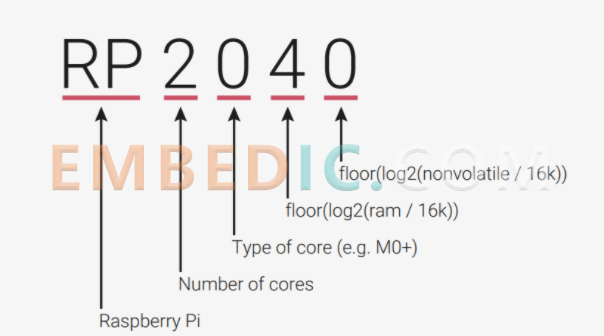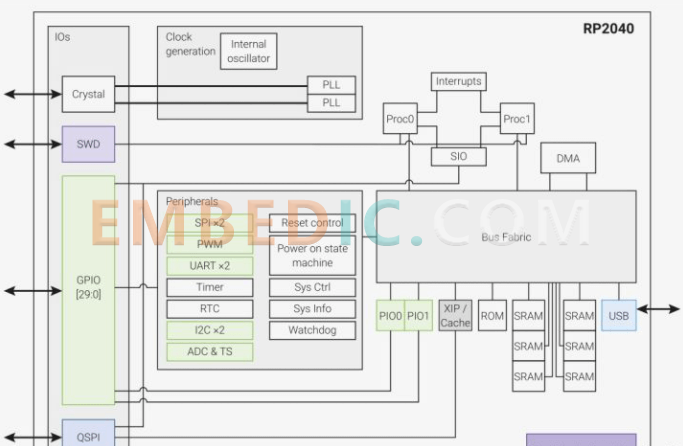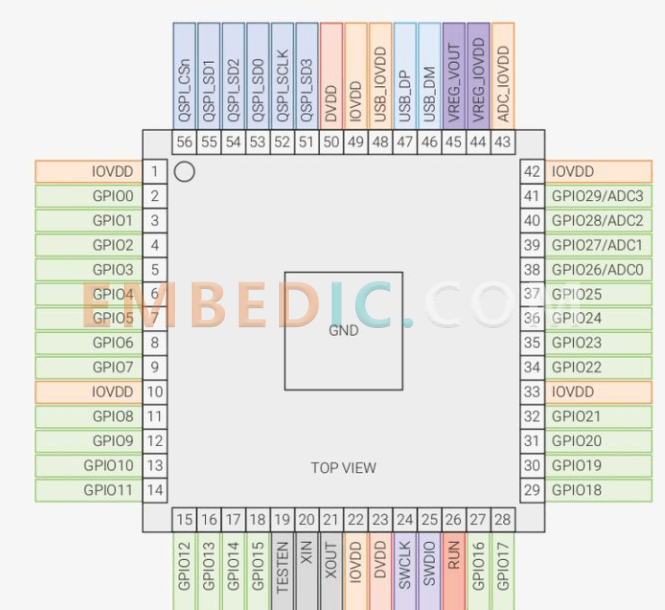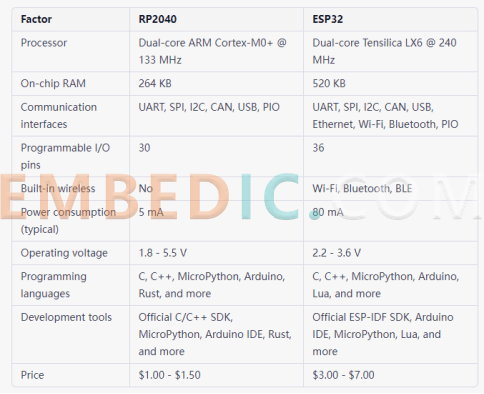RP2040 and ESP32 are both popular microcontrollers used in the embedded systems industry. RP2040 is a microcontroller developed by Raspberry Pi Foundation. It features a dual-core ARM Cortex-M0+ processor, 264kB of on-chip RAM, and a range of input/output (I/O) options. RP2040 is designed for high performance, low power consumption, and low cost.
ESP32 is a microcontroller developed by Espressif Systems. It features a dual-core Tensilica LX6 processor, 520kB of SRAM, and built-in Wi-Fi and Bluetooth connectivity. ESP32 is designed for high performance, low power consumption, and connectivity, making it well-suited for IoT and home automation projects.

RP2040 is a microcontroller designed and produced by Raspberry Pi Foundation. It was released in 2021 and has quickly gained popularity in the embedded systems industry due to its high performance, low cost, and strong community support.
RP2040 is based on a dual-core ARM Cortex-M0+ processor and features 264KB of on-chip RAM, 30 programmable I/O pins, a programmable input/output (PIO) subsystem, and a range of communication interfaces, including UART, SPI, and I2C. It also features a unique programmable input/output (PIO) subsystem, which allows for custom logic and peripheral emulation.
RP2040 is designed for a wide range of applications, including robotics, automation, sensing and measurement, and more. Its high performance and low power consumption make it ideal for battery-powered devices and applications that require real-time processing. In addition, its low cost and strong community support make it an attractive option for hobbyists and makers.
RP2040 can be programmed using a variety of programming languages, including C, C++, MicroPython, and CircuitPython, and can be programmed using a variety of development tools, including the official Raspberry Pi Pico SDK and third-party development tools such as Arduino and PlatformIO.
Here are the specifications of the RP2040 microcontroller:
The RP2040 also supports a variety of programming languages, including C, C++, MicroPython, and CircuitPython, and can be programmed using a range of development tools, including the official Raspberry Pi Pico SDK, as well as third-party tools such as Arduino and PlatformIO.
Advantages:
High performance: RP2040 features a dual-core ARM Cortex-M0+ processor that provides high performance and low power consumption.
Low cost: RP2040 is an affordable microcontroller, making it an attractive option for hobbyists and makers.
Ample memory: RP2040 has 264KB of on-chip RAM, providing ample memory for a wide range of applications.
Programmable input/output (PIO) subsystem: RP2040's unique programmable input/output (PIO) subsystem allows for custom logic and peripheral emulation.
Easy to program: RP2040 supports a variety of programming languages and development tools, making it easy to program and integrate into projects.
Disadvantages:
Limited peripherals: RP2040 has limited peripherals compared to some other microcontrollers, which may limit its use in certain applications.
No built-in Wi-Fi or Bluetooth: RP2040 does not have built-in Wi-Fi or Bluetooth connectivity, which may limit its use in certain IoT applications.
Newer technology: RP2040 is a relatively new microcontroller, which means that it may not have as much community support or available resources as some more established microcontrollers.


You may like: How the RP2040 MCU Became a Popular Development Board Chip 2023
ESP32 is a popular dual-core microcontroller designed by Espressif Systems. It is based on the Tensilica Xtensa LX6 processor and includes integrated Wi-Fi, Bluetooth, and Bluetooth Low Energy (BLE) connectivity.
The ESP32 also includes a range of peripherals and interfaces, such as UART, SPI, I2C, and Ethernet, making it a versatile choice for a range of applications.
Additionally, the ESP32 supports a variety of programming languages, including C, C++, MicroPython, Lua, and Arduino, and can be programmed using the official ESP-IDF SDK or various third-party development tools. Due to its features and capabilities, the ESP32 is widely used in the Internet of Things (IoT), home automation, and robotics industries.
Microprocessor: Tensilica Xtensa dual-core 32-bit LX6 microprocessor, running at up to 240 MHz
Memory:
Wireless Connectivity:
Peripherals:
Power Management:
Other Features:
RP2040 and ESP32 are both powerful microcontrollers with dual-core processors that are popular in the embedded systems industry. Here are some similarities and differences between the two:

Dual-core processors: Both RP2040 and ESP32 have dual-core processors, which provide high performance and low power consumption.
Programmable input/output (PIO) subsystem: Both RP2040 and ESP32 have programmable input/output (PIO) subsystems, which allow for custom logic and peripheral emulation.
Communication interfaces: Both RP2040 and ESP32 have a range of communication interfaces, including UART, SPI, and I2C, which allow for easy interfacing with a wide range of devices.
Support for popular programming languages: Both RP2040 and ESP32 can be programmed using popular programming languages such as C, C++, MicroPython, and Arduino.
On-chip RAM: RP2040 has 264KB of on-chip RAM, while ESP32 has 520KB of on-chip RAM, giving ESP32 an advantage in memory-intensive applications.
Built-in Wi-Fi and Bluetooth connectivity: ESP32 has built-in Wi-Fi and Bluetooth connectivity, making it easier to create Internet of Things (IoT) applications that require wireless connectivity.
Number of I/O pins: RP2040 has 30 programmable I/O pins, while ESP32 has 36 programmable I/O pins, giving ESP32 an advantage in applications that require a large number of I/O pins.
Development tools: While both RP2040 and ESP32 can be programmed using a variety of development tools, there are some differences in the availability and quality of the tools.
Price: RP2040 is generally less expensive than ESP32, making it a more cost-effective option for some applications.
Overall, while both RP2040 and ESP32 have some similarities in terms of their dual-core processors and programmable I/O subsystems, there are some key differences between the two in terms of on-chip RAM, built-in Wi-Fi and Bluetooth connectivity, number of I/O pins, and development tools. The choice between the two will depend on the specific requirements of the application at hand.
It's not necessarily accurate to say that ESP32 is better than RP2040 or vice versa, as each microcontroller has its own strengths and weaknesses, and the choice between them depends on the specific requirements of the project. That being said, here are a few reasons why someone might choose ESP32 over RP2040:
Built-in Wi-Fi and Bluetooth: One of the biggest advantages of ESP32 over RP2040 is its built-in Wi-Fi and Bluetooth connectivity. If the project requires wireless communication, this can be a major advantage over RP2040, which does not have built-in wireless connectivity.
More peripherals and interfaces: ESP32 includes a wider range of peripherals and interfaces than RP2040, including Ethernet, SD/SDIO/MMC, and CAN 2.0 support. This can make it a better choice for projects that require these specific interfaces.
Greater availability: ESP32 is a more established and widely-used microcontroller than RP2040, and as a result, it may be easier to find documentation, tutorials, and support for it.
In conclusion, both RP2040 and ESP32 are powerful and versatile microcontrollers that have gained popularity in the embedded systems industry. While RP2040 has advantages such as higher clock speed, more on-chip RAM, and lower power consumption, ESP32 stands out with its built-in Wi-Fi and Bluetooth connectivity, more peripherals and interfaces, and greater availability.
When choosing between these two microcontrollers, it is important to consider the specific requirements of the project and which features and capabilities are most important. Both RP2040 and ESP32 offer a wide range of applications and can be used in many different projects, from simple hobbyist projects to complex IoT applications.
Overall, the choice between RP2040 and ESP32 depends on the specific needs of the project, and each microcontroller has its own strengths and weaknesses. By understanding the similarities and differences between these microcontrollers, developers can choose the best option for their specific application and create innovative and powerful embedded systems.
Further Reading:
ESP32 vs STM32, Which is Better and How to Choose 2023
ESP32 vs ESP8266, Which is Better and How to Choose?
ESP32 vs Arduino: What are Differences and How to Choose
Manufacturer: Texas Instruments
IC DSP FIX/FLOAT POINT 176HLQFP
Product Categories: DSP
Lifecycle:
RoHS:
Manufacturer: Microchip
IC MCU 8BIT 28KB FLASH 40UQFN
Product Categories: 8bit MCU
Lifecycle:
RoHS:
Manufacturer: Texas Instruments
IC DSP FIX/FLOAT POINT 176HLQFP
Product Categories: DSP
Lifecycle:
RoHS:
Manufacturer: Texas Instruments
IC DGTL MEDIA PROCESSR 1031FCBGA
Product Categories: DSP
Lifecycle:
RoHS:
Looking forward to your comment
Comment